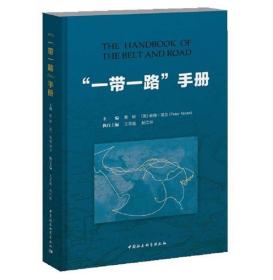
“一带一路”手册
06-09-20
¥ 24.9 1.3折 ¥ 198 九五品
仅1件
广东东莞
认证卖家担保交易快速发货售后保障
作者蔡昉、[英]彼得·诺兰 编
出版社中国社会科学出版社
出版时间2019-04
版次1
装帧平装
货号06-09-20
上书时间2024-09-29
- 最新上架
商品详情
- 品相描述:九五品
图书标准信息
- 作者 蔡昉、[英]彼得·诺兰 编
- 出版社 中国社会科学出版社
- 出版时间 2019-04
- 版次 1
- ISBN 9787520341431
- 定价 198.00元
- 装帧 平装
- 开本 16开
- 纸张 胶版纸
- 页数 716页
- 字数 905千字
- 【内容简介】
-
The countries of the world are at different stages of development and have their own differenthistories and cultures, but the people of all countries share a common desire for peace and development. It is also the goal and constant commitment of the ruler of every country toraise the country's economic and social development level with a view to bringing peopleout of poverty and improving people's quality oflife. Meanwhile, people tend to agree thata country should also accommodate the legitimate concems of others when seeking its owndevelopment and the common development of all countries is the only way for a country toachieve its sustainable development. Since Comrade Xi Jinping was elected the president ofChina in 2013, he has consistently advocated and made profound interpretations of the ideaof building a community of shared future for mankind, which has quickly gained widespreadrecognition from the international community. The idea itself has also been recorded in aseries of UN resolutions.
A desire for common development does not mean the pursuit of a single path, nor doesit entails a single model. Instead, it allows diversified and localised development pathsthat keep abreast with the times. However, all countries also face common obstacles intheir development, such as a bottleneck of capital accumulation, inequality in intemationaleconomic and trade relations, low infrastructure capacity, difficulties in cultivating humancapital, and low mobilization capability and inefficient allocation of human resources.Therefore, while acknowledging and encouraging diversified models, all countries aroundthe world, especially the developing countries, are also desperate for a strategic frameworkfor development that not only helps to create the necessary conditions for development,breaking the bottlenecks in key areas and learning from success or failure, but also gives each country an adequate space of choice. The Belt and Road Initiative proposed by Chinese President Xi Jinping in 2013 is such an open fiamework. - 【作者简介】
-
蔡昉(CAI Fang),Editor in Chief, is the Vice President of Chinese Academy of Social Sciences.He is a member of the Standing Committee and Vice Chairman of the Agricultural & Rural Affairs Committee of the 13th National People's Congress of China. His research interests include labor economics, China's economic growth, and income distribution, etc.
Professor Cai's recent publications include: Demystifying the Economic Growth in Transition China and China s Economic Growth Prospects: From Demographic Dividend to Reform Dividend,etc.
彼得·诺兰(Peter Nolan),Editor in Chief, is Professor of Chinese Development and Director of the Centre of Development Studies, University of Cambridge, UK. - 【目录】
-
LIST OF CONTRIBUTORS
Foreword
Preface: The Silk Road by land and sea
PART Ⅰ
Contribution of China's Reform and Opening-Up to the World and
Formation of the Belt and Road Initiative
1.The Historic Contribution of China's Reform and Opening-Up to the World
2.Developing an Open Economy and the Belt and Road
3.China's Economic Restructuring and the Belt and Road
4.Innovation-driven Development and the Belt and Road
5.Responsibilities of China and the Belt and Road
6.Confidence of a Major Country and the Belt and Road
7.Deficit in Development and the Belt and Road
8.Deficit in Peace and the Belt and Road
9.Deficit in Govemance and the Belt and Road
PART Ⅱ
Historic In heritance
10.Naming of the Silk Road
11.A Brief History of the Silk Road
12.The Overland Silk Road
13.The Maritime Silk Road
14.Silk Road and Exchanges Among Different Countries
15.The Silk Road Spirit
PART Ⅲ
Formation and Framework of the Concept
16.Process for Proposing the Concept
17. Background
18.The Belt and Road Initiative Framework
19.Basic Contents
20.Basic Principles
21.Partners
22.General Ideas
23.Directions of Cooperation
24.Cooperation Mechanisms
25.Organisational Structure
PART Ⅳ The Five Roads
26.The Belt and Road Initiative and the Road of Peace
27.The Belt and Road Initiative and the Road of Prosperity
28.The Belt and Road Initiative and the Road of Openness
29.The Belt and Road Initiative and the Road of lnnovation
PART Ⅴ
Five Types of Connectivity
PART Ⅵ
The Six Economic Corridors
PART Ⅶ
Theories and Concepts of the Foreign Affairs with Chinese Characteristics
PART Ⅷ
Core Concepts
PART Ⅸ
Belt and Road Forum for International Cooperation
PART Ⅹ
International Action Plans Relevant to the Belt with Road Initiative
PART Ⅺ
International Plans Similar to the Belt and Road Initiative
PART Ⅻ
Cases Studies of BRI Implementation and Promotion
点击展开
点击收起
相关推荐
— 没有更多了 —




















以下为对购买帮助不大的评价